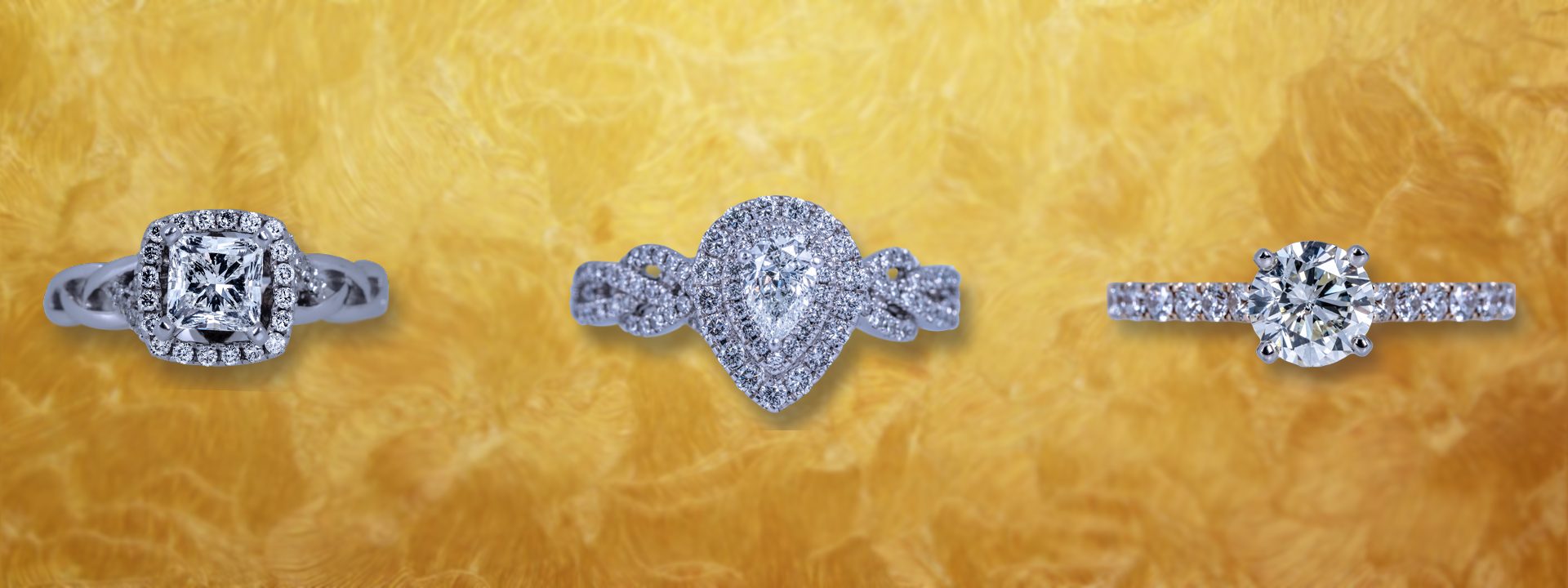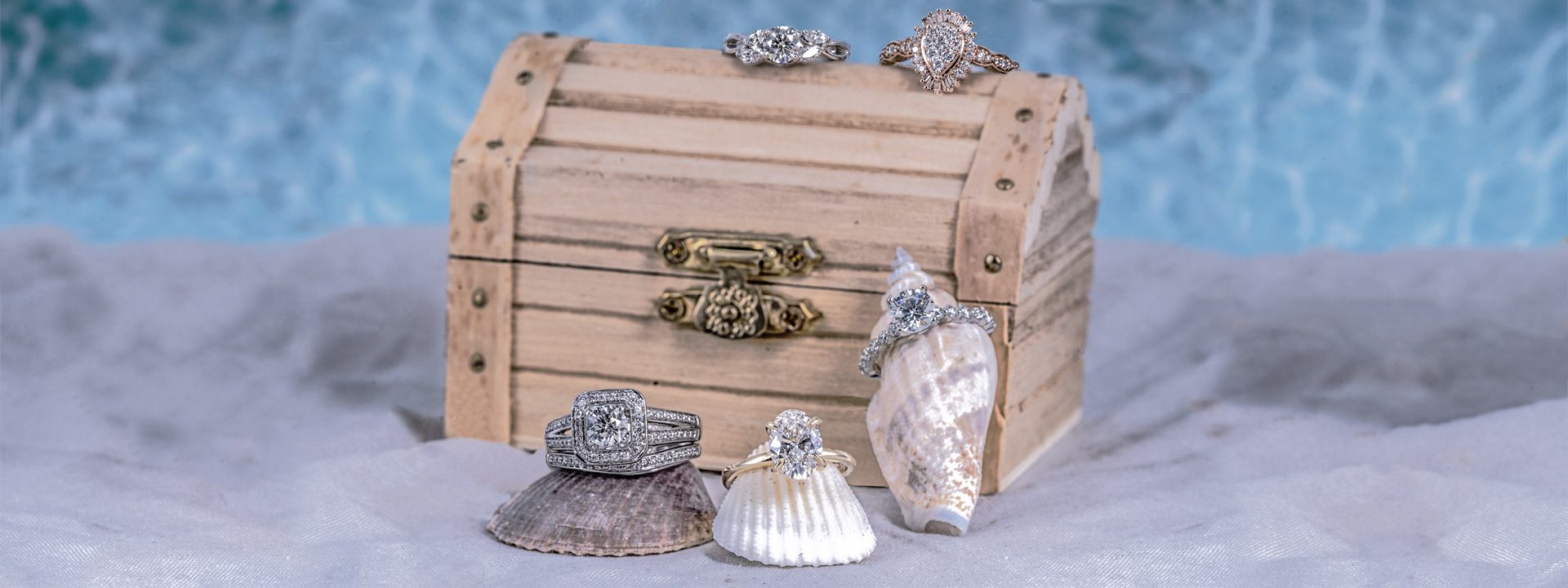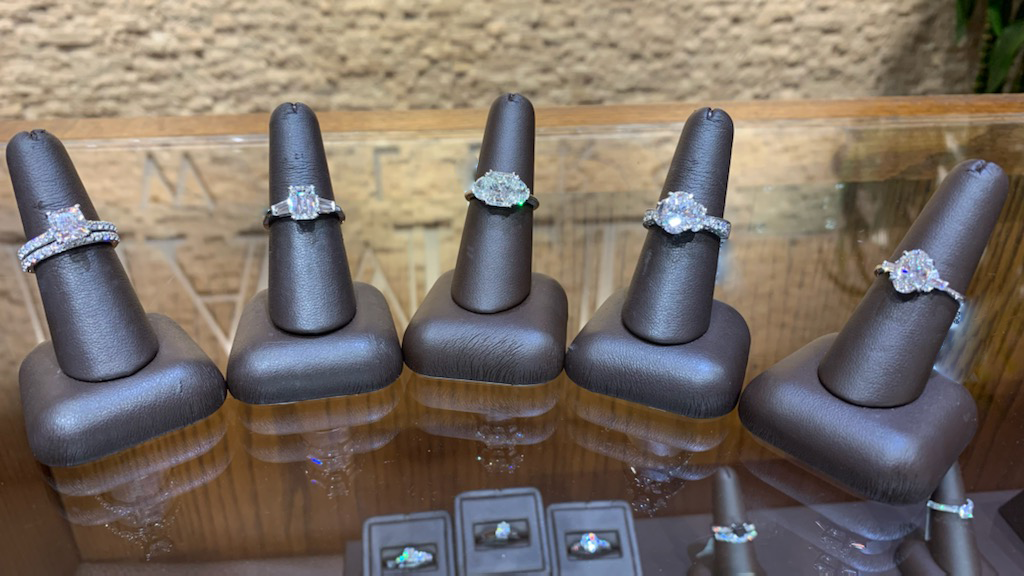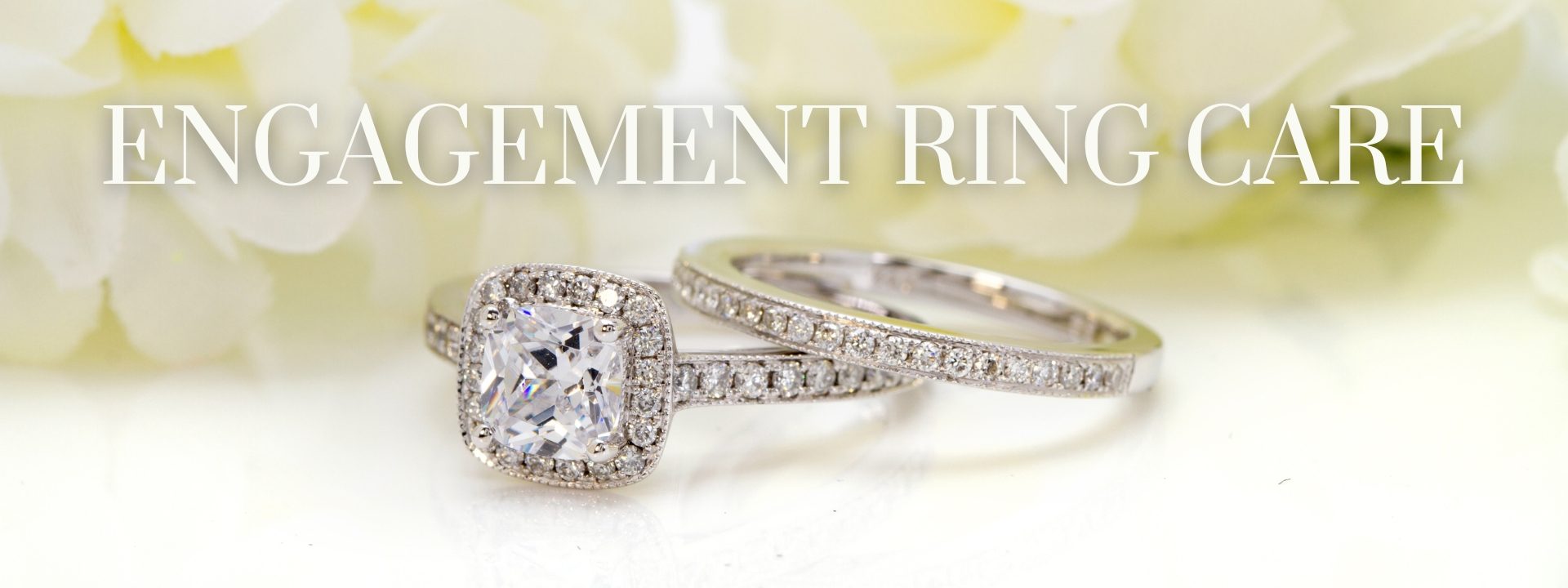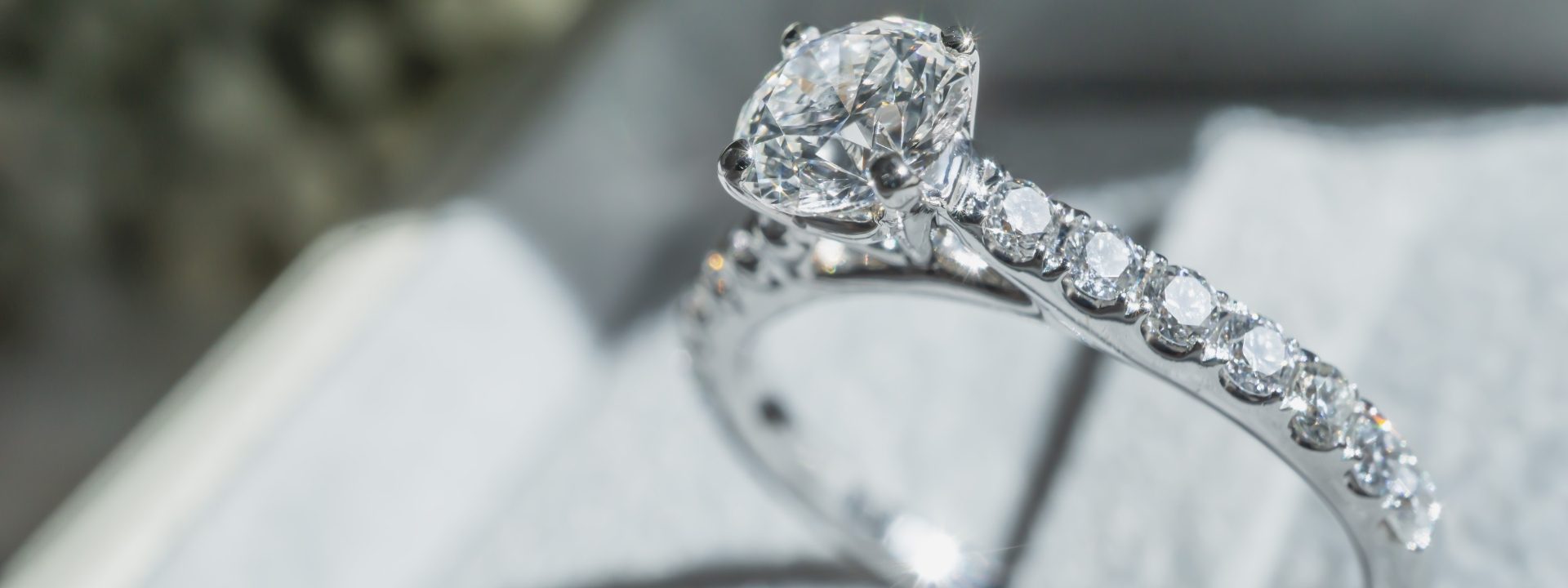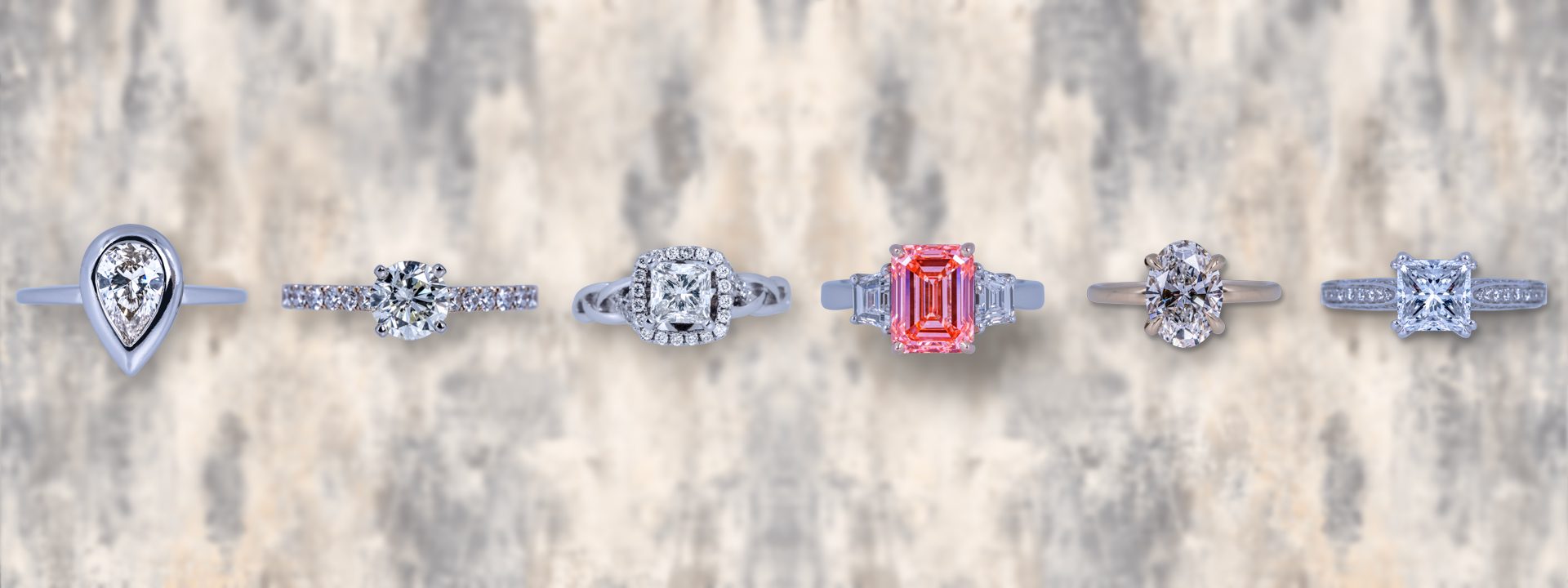
The diamond, or any other gemstone, is the center of attention in any engagement ring. But the way it sparkles and shines can be affected by one important factor that many people tend to overlook – the setting. There are many different choices for engagement ring settings, also referred to as a mounting or semi-mounts. From the classic prong setting to bezel settings, to the modern tension setting, it can quickly become very overwhelming. But that doesn’t mean your decision shouldn’t involve careful consideration.
As you may already know, the 4Cs of a diamond determine its overall quality and appearance. However, engagement ring settings also play an important role. The mounting defines the look of your ring and displays the diamond to its best advantage. The way the diamond is set, and the color of metal chosen, can significantly impact the final look of your ring.
You don’t want to fall in love with a loose diamond, select a style of setting you’ve always admired, and then ultimately decide you don’t like how they look together on your finger. You’d have to start the entire process all over again! That’s why it’s best to consider the ring mounting before making any purchases.
It’s also wise to think about your lifestyle and budget. If you lead a more active lifestyle and plan to wear your engagement ring every day, it’s best to choose a setting that offers more protection for the diamond. Think about your ring being snagged on clothes or in hair, getting banged against your desk or walls, etc.
Additionally, it’s always smart to think about your budget. While the diamond itself can make up a significant part of the overall cost of the ring, the type and amount of precious metal plus additional diamonds or gemstones used in the setting helps determine the total price.
And don’t forget about the wedding band! Do you plan on wearing your engagement ring and wedding band together? If so, you more than likely want them to sit perfectly together and share cohesive design elements. A great way to ensure this is by purchasing a wedding set.
A duo will include an engagement ring and women’s wedding band, while a trio will include an engagement ring plus his-and-hers matching wedding bands. This can help you save money, but you always have the choice of purchasing each ring separately, and even custom designing your rings.
As you can tell, there are many different factors that go into selecting the perfect engagement ring setting for you. Luckily, we’re here to help you make your decision. Below are some of the many different types of ring settings with a brief list of pros and cons for each one.
Classic Prong Setting - Solitaire
This is the most common setting for engagement rings. Prong settings involve three to six prongs, or claws, that hold a stone firmly in place in a metal “basket.” This type of setting offers a few different options: prongs can be round, flat, pointed, or V-shaped. Four or six prongs are the most common, but this can vary depending on the shape of the diamond. Fewer prongs allow for more exposure to light and thus more sparkle, but more prongs keep the diamond more secure. Solitaire prong settings consist of a band and prongs to hold the diamond – nothing more.
Pros:
- Allows for light exposure from all angles, which maximizes the diamond’s brilliance
- Less expensive since less metal is required in the making of the setting
- Supports a variety of shapes and carat sizes
- Easy to clean
- Timeless appeal
- Shows the diamond off as the star of the piece
Cons:
- May offer less protection of the diamond than other settings
- Can get caught in hair or snag clothing. Beware of long-sleeved shirts, stockings/nylons, and gloves.
- May loosen with normal wear and tear (although, this is a simple fix at your local jewelers).
Channel Set Engagement Rings
This specific setting refers to the band of an engagement ring and is also widely popular for wedding bands. The channel setting features smaller diamonds inserted into a channel that is cut into the band of the ring. This creates a metal channel of sparkling stones set flush with the entire band or most of the band. Most channel settings feature round or princess cut diamonds. The advantage to using princess cut diamonds is there will be no gaps between the stones set in the channel, making the ring sparkle even more.
Pros:
- Secure; offers protection to the girdle of stones
- Smooth surface
- Enhances ring’s overall fire and brilliance
Cons:
- Can be difficult to resize if set with stones around the entire perimeter of the band. We recommend leaving one third of the band unset in case of future repairs
- Requires more cleaning to avoid dirt becoming trapped in the channel
- Not recommended for soft stones
Bezel Set Engagement Rings
A bezel setting is the best engagement ring setting for those who lead active lifestyles. This is because the bezel setting offers maximum protection of the stone. The bezel setting encircles the diamond with a metal rim, either completely or partially. A full bezel completely surrounds the diamond, whereas a partial bezel leaves the sides open for more viewing of the diamond.
Pros:
- Offers maximum protection of the diamond
- Easy to clean and maintain
- Sleek and modern style
- Metal can be molded to fit any shape and carat
- White metals can make diamonds appear larger
- Yellow gold can enhance the color of red or green gemstones
Cons:
- Less light reflection, which means less brilliance
- Hides more of the stone
- Yellow gold may give colorless diamond a slight yellow tint.
Pavé Settings
Similar to the channel setting, a pavé setting features diamonds encrusted around the perimeter of the band. However, instead of diamonds embedded within the band, several rows of small stones are set level with the surface of the ring. Then, the surrounding metal is raised to form beads, like little prongs, that secure the stones in place. The finished look gives the impression that the ring setting is made entirely out of diamonds.
Pros:
- Continuous sparkle
- Design complements modern and vintage styles
Cons:
- Can be difficult to resize if set with stones around the entire perimeter of the band. We recommend leaving about one third of the band unset in case of future repairs.
- Small risk of losing side stones
Tension Settings
A more modern approach to engagement ring settings, the tension setting gives the impression that the stone is floating. This type of setting features a design in which the compression-spring pressure of the band holds the stone securely in place. Jewelers expertly cut tiny grooves into the side of the band to secure the diamond in place. Diamonds, sapphires, and rubies are the only gemstones that are durable enough to withstand the required amount of pressure. There are also tension-style ring settings that have an additional metal band surrounding the diamond.
Pros:
- Can see nearly 100% of the diamond
- Ultimate light reflection due to minimal metal surrounding the diamond
- Unique and modern appearance
Cons:
- Difficult and expensive to resize
- Thick metal bands can create the appearance of a smaller diamond
- Extreme pressure from an outside source can cause the diamond to become loose (highly unlikely, but still possible)
Bar Settings
Bar settings are more common in wedding and anniversary bands, but they are still used in engagement rings. Two metal bars secure the stone in place, leaving the sides exposed for viewing. This setting is similar to the design of channel setting, however, more of the diamond is visible.
Pros:
- Versatile design that works well for engagement rings, bands, and stackable rings
- Amplifies sparkle and shine
Cons:
- Resizing can be challenging and costly
- Slightly higher chance of chipping since there is less metal protecting the stone.
Halo Settings
Halo settings are one of the most popular settings for engagement rings. Smaller diamonds or other gemstones encompass the center stone, creating a look of ultimate sparkle. Halos are more commonly seen with round or princess cut diamonds, but they look great with any shape. This is a great option for smaller center stones since the halo makes them appear larger. There are also double halos, which feature two concentric circles of gemstones surrounding the center stone.
Pros:
- Maximizes sparkle and shine
- Complements a variety of diamond shapes
- Enhances appearance of smaller diamonds
- Can be paired with a pavé band for a look of continuous sparkle
Cons:
- Tiny side stones have the potential to come loose
Cathedral Settings
Cathedral settings have an elegant and classic appeal. This mounting is similar to the classic prong setting, but the diamond is set much higher up on the band. Metal arches are used to hold the center stone, much like the graceful arches of a cathedral. The arches are used to add extra height to the ring, elevating the center stone and making it the center of attention.
Pros:
- Unique and eye-catching design
- Showcases the center stone
- Very secure
- Cost-saving style; less money than adding more diamonds
Cons:
- Can snag on clothing
- Easier to accidentally hit on hard surfaces since the stone is set so high
Three-Stone Engagement Rings
Appropriately named, three-stone engagement ring settings feature three stones: a larger center stone and two smaller side stones. This setting has a special meaning behind it as the three stones are said to represent a couple’s past, present, and future. Round brilliant and princess cut diamonds are the most popular for this particular setting. Personalization is an option by using different colored stones.
Pros:
- More brilliance and fire
- Opportunity for color contrast and personalization
- When properly paired with side stones, the center stone appears larger
Cons:
- More cleaning and maintenance required
- Side stones might distract from beauty of center stone when paired poorly
Gypsy Settings
Gypsy settings, also known as flush settings, feature a diamond drilled into a hole in the band of the ring. Metal is pressed and hammered around the stone to secure it; the gemstone does not protrude at all. This is a very popular style for men’s wedding bands.
Pros:
- Very secure
- Maximum protection of the stone
- Conceals any nicks or chips on the stone’s girdle, which can be cost effective when selecting a diamond
Cons:
- Not recommended for fragile stones
- More expensive than other engagement ring setting since it takes more time and effort to produce
Cluster Settings
Cluster settings are one of the newer styles for engagement rings. Many smaller diamonds are clustered together to create the appearance of a larger diamond. This style of setting can contain a larger centered stone with many small stones clustered around it, or a cluster of stones of equal size.
Pros:
- Unique and modern design
- Can be crafted into many different shapes
- Less expensive than purchasing a larger diamond
Cons:
- More cleaning and maintenance required depending on number of stones and shape
- Smaller stones can potentially become loose and fall out
Split-Shank Bands
Shank is another term for band. Therefore, this type of mounting features a split in the band. The band splits into two separate shanks that come together at the center stone. Channel settings and pavé settings are typically combined with this style to provide more texture and sparkle.
Pros:
- Works well with modern and vintage designs
- Different from traditional styles
- Offers more surface area for more side stones
- Offers a number of variations on design
Cons:
- More difficult to pair with wedding bands, but still possible
- Requires more cleaning and maintenance
Affordable Engagement Rings and Settings at Leo Hamel's
Now that you have a bit more knowledge about specific engagement ring settings, we hope you’ve been able to narrow it down to your favorites. Keep in mind that no specific setting for rings is superior to the others; it’s all just a matter of preference, lifestyle, and budget. So, which engagement ring setting is your favorite? Still can’t decide? Stop by our jewelry store on San Diego Avenue to try on different ring settings. Our experts will help you find your dream engagement ring at a price that is right for you.

